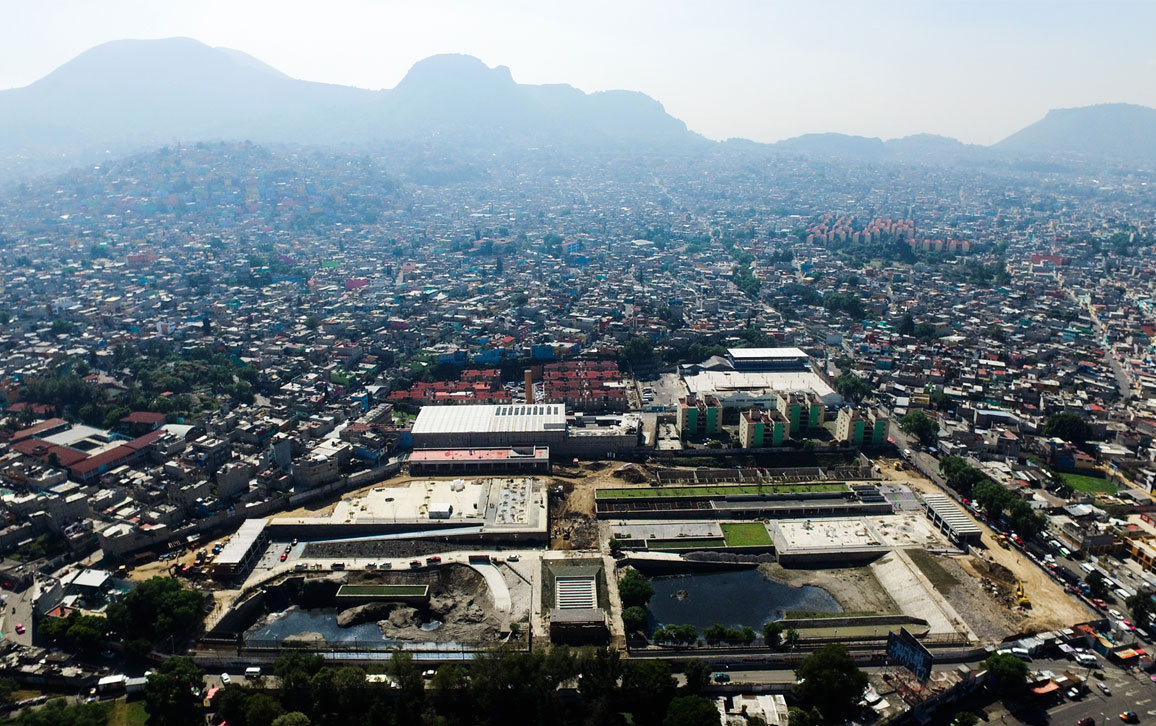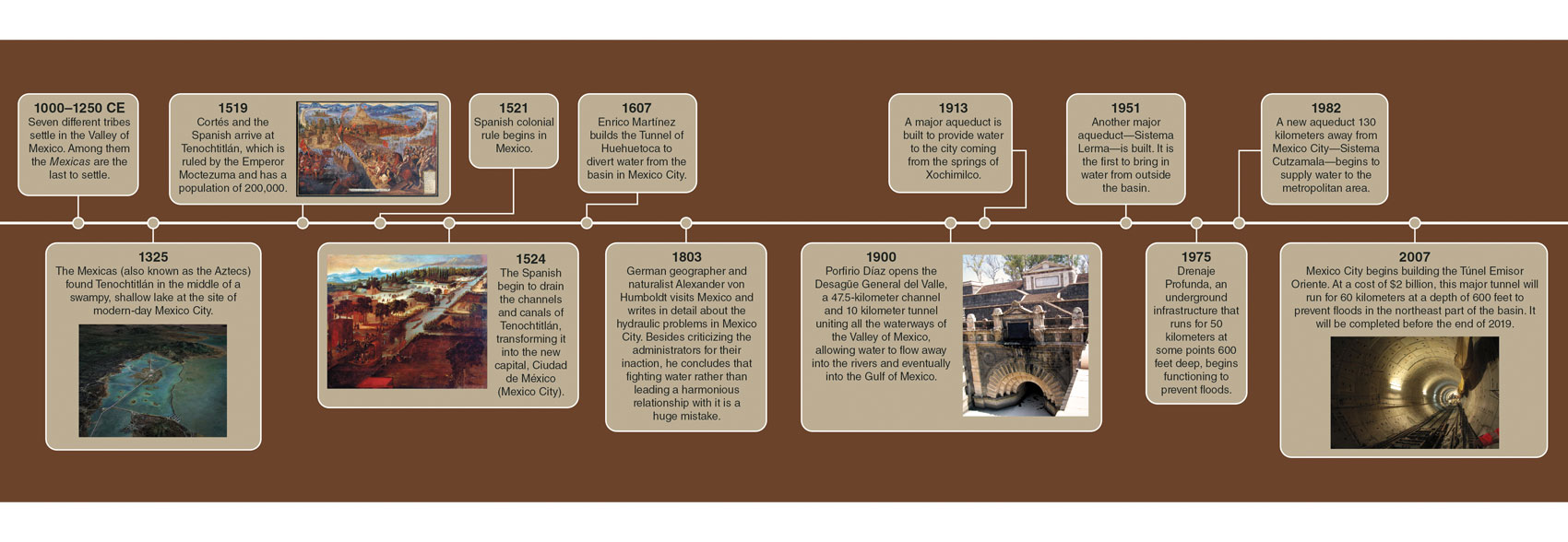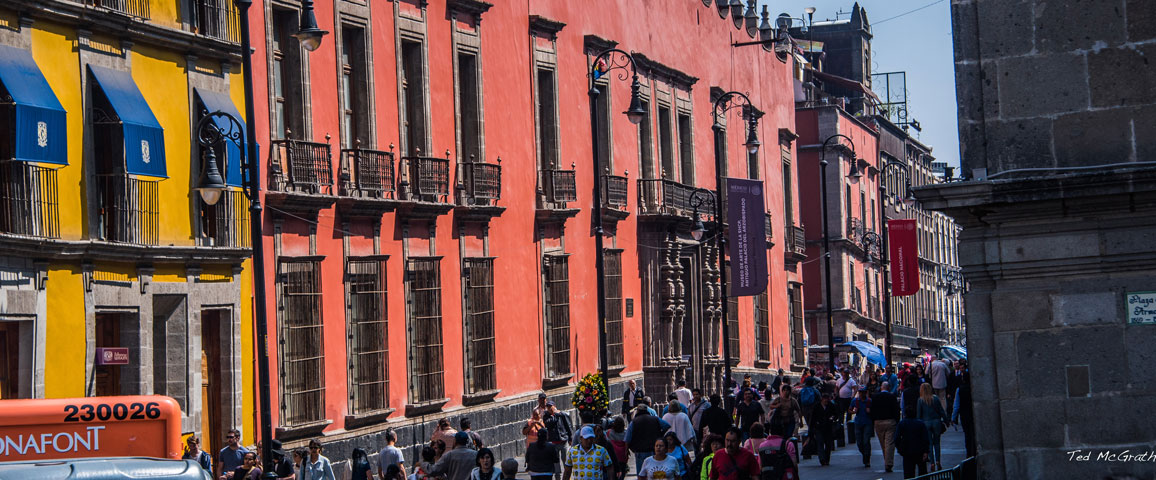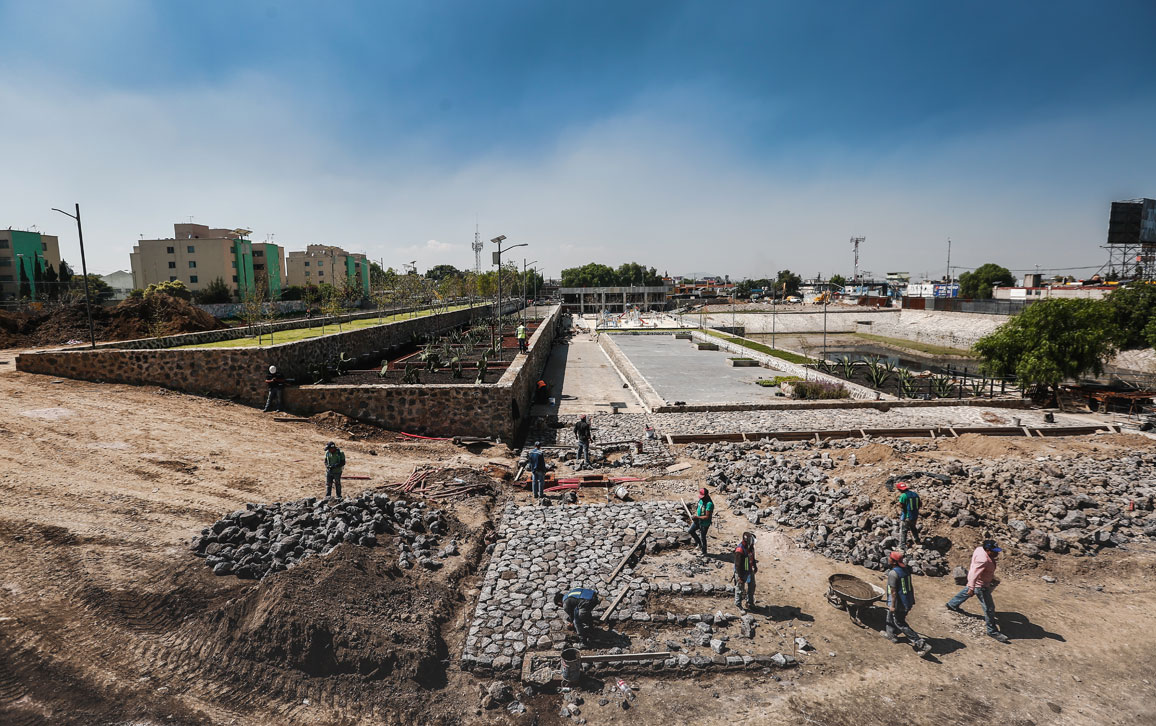Thirsty City on a Lake
By Manuel Perlo, Loreta Castro-Reguera Mancera
Introducing sustainability into Mexico City’s hydrological infrastructure could evade a water crisis.
Introducing sustainability into Mexico City’s hydrological infrastructure could evade a water crisis.

In Mexico City, where water surplus and scarcity have shaped life for centuries, an emblematic new park highlights how projects that integrate water management within public spaces could support a more sustainable future.
La Quebradora Hydraulic Park, currently under construction in Itztapalapa—a low-income, crime-ridden borough—will soon serve as a central gathering hub. The project reshapes a four-hectare flood basin that collects rains from a nearby hillside but is polluted from its use as a dumping ground. In its new incarnation, volcanic stone terraces will funnel water into basins and constructed wetlands. A small sewage treatment plant will cleanse the water, supplying public bathrooms, a community center, and outdoor recreational facilities for nearby residents.

Guillerma Mendía/Estudio Rizoma
This park, which we designed several years ago, highlights our novel water management strategy: marrying large-scale engineering with a modern conservation approach incorporating landscape features. Many such projects peppered throughout the city could have a big collective impact.
Mexico City is hardly the only global city shaped by thirst and floods. From ancient Rome to 20th-century Los Angeles, cities have built infrastructure to slake their thirst. Venice’s foundations are slowly submerging.
But some of Mexico City’s challenges are unique: Mexico City has faced thirst and floods simultaneously for almost 700 years. Sitting in a closed basin surrounded by five high mountain ranges, the city has suffered repeated flooding, but also struggles to supply its growing population with enough clean drinking water. Without rivers or an ocean that can serve as natural drainage, Mexico City has built a complex network of tunnels over centuries to carry away excess rainfall and sewage. At the same time, the many creeks and small dams can’t provide enough freshwater to meet demand. Traditional water management methods—pumping in drinking water from outside and pumping out excess rainfall and sewage—have proved insufficient. As a result, the city draws much of its water from deep aquifers below its foundations, a process that compromises the clay, gravel, and sand that support it. The foundation is sinking by as much as 20 centimeters each year. Today’s population of 22 million exacerbates the forces of scarcity, flash floods, and ground subsidence that have been growing. Without better management in the 21st century, water woes could push the city and its citizens to a breaking point.
Using sustainable urban design, our water management approach would alter Mexico City’s relationship with water. Each small project, tailored to the unique geographic, environmental, social, and policy needs of the community, can provide sustainable sources of clean water. Collectively these projects could put a significant dent in the growing water needs of this expanding megalopolis and offer potential solutions for water challenges elsewhere.
Today’s Mexico City sprawls across the Valley of Mexico 900 kilometers south of Texas between the Gulf of Mexico and the Pacific Ocean. The mountain snowpack feeds hundreds of springs and dozens of small-to-medium–size rivers that grow during the rainy season and flow into the lowlands to form a now-extinct, five-lake system of 1100 square kilometers.
Mexico City has faced thirst and floods simultaneously for almost 700 years.
Several earlier settlements were built here over the centuries. Mexico City’s immediate predecessor, Tenochtitlán, was founded in 1325 by the Mexicas (also called the Aztecs). This tribe was the last of seven to migrate from the north between 1000 and 1250 and settle in the Valley of Mexico. Pushed around and harassed for two centuries by the groups who arrived first, the Mexicas wandered within the valley before they established a permanent settlement in a small islet deep within one of these lakes. That decision, whether inspired by religious or strategic reasons, permanently sealed the city’s future and its close relationship with water. Tenochtitlán—and later Mexico City—would forever after benefit from its watery connections and be imperiled by water’s destructive power.
Over the next two centuries, the Mexicas built impressive infrastructure: a system of aqueducts, waterways, dikes, floodgates, and reservoirs. They served one of the most productive agricultural systems known in ancient times called chinampas, which supported a city of 250,000 inhabitants and helped them develop a vast empire that dominated Mesoamerica before the arrival of the Spaniards in 1517. That engineering success was severely tested by three major floods between 1380 and 1500 and two droughts within five years during the mid-15th century.
During the two-year Spanish conquest of the Mexicas, controlling the water proved decisive. As the Spanish leader Hernán Cortés besieged Tenochtitlán and prepared the final assault, he cut the water supply to the city, destroying the levees and dikes that prevented floods. After the Mexicas’ defeat in 1521, Tenochtitlán was in ruins. Against the advice of his generals, Cortés built the new capital city precisely on top of the destroyed one. This central location offered military advantages and replaced the sacred temple of the Mexicas, a potent symbol of their power, but it was the worst possible choice from a hydrological point of view.
During the three centuries of Spanish colonial rule, Mexico City developed a new relationship with water. Its channels were filled, and water was kept outside. It transformed from a city built within a lake to a city built on top of a lake.
Nature was kind to the Spanish during the early decades of their rule, but in 1555, 1580, and 1605, severe storms flooded the city. At first, the colonial regime built and restored the hydraulic infrastructure that served Tenochtitlán: dikes, floodgates, aqueducts, and embankments. After a catastrophic flood in 1607, the Spanish tried new approaches imported from Europe. The viceroy sponsored a public contest for projects that could save the city from flooding. The winner, Enrico Martínez—an enigmatic and ultimately tragic polymath with interests ranging from linguistics to engineering—convinced the colonial authorities to build a tunnel through the northern low Sierras that would divert excess water from the Cuautitlán River. After 11 months of work, the tunnel—6.6 kilometers long and 3.5 meters in diameter—was completed in 1608.

Water has shaped Mexico City’s history for seven centuries. The Mexicas built Tenochtitlán, a city within a swampy lake. From the Spanish colonial period to the present day, Mexico City has managed its water primarily through a complex system of tunnels and aqueducts.
illustration Barbara Aulicino; Tomás Filsinger (left); Wikimedia Commons (center 3); Loreta Castro-Reguera (right)
But high waters still plagued the prosperous capital of New Spain. After the catastrophic flood of 1629, the city remained flooded for five years. (Martínez was blamed for the catastrophe, imprisoned, and prosecuted by the Spanish Inquisition.) The colonial authorities considered moving the capital to a safer place, but eventually rebuilt Mexico City in the same location and did little to prevent flooding, which occurred regularly over the next 200 years. During these years, the colonial authorities took steps to boost the supply of fresh water, building a series of aqueducts into Mexico City and surrounding areas.
After a war of independence lasting more than a decade, Mexico became an independent nation in 1821. National authorities acknowledged the need to prevent and mitigate flooding in Mexico City. They initially pursued Enrico Martínez’s solution from two centuries before: They would expel excess water from the valley by building large channels underneath the city and dig tunnels across the northern low Sierras. They did not use canals and dikes, strategies employed successfully by the Mexicas and on a limited scale by colonial authorities during the 16th century. Overall, the population viewed flooding as inevitable and impossible to prevent.
Limited money and political instability stalled progress. Native and foreign engineers proposed promising water management projects that were never built.
Meanwhile, another water problem emerged: the lack and poor quality of drinking water. As the population continued to grow throughout the 19th century, water demand increased beyond the available supply from the aqueducts. Families and businesses installed steam-powered wells, but most were shallow, up to 30 meters deep, and were contaminated by sewage. In 1833, five percent of Mexico City’s population died in a cholera epidemic. Disease ravaged the city in both 1850 and 1857. Typhoid fever was rampant from 1874 to 1877.
At the end of the 19th century, Mexico City finally pulled together resources to address flooding again. Mexico’s 30-year president, Porfirio Díaz, assembled both loans and technology to organize and build an enormous public works project. The Desagüe General del Valle united the most important lakes and rivers of the valley and built on Enrico Martínez’s 1607 water management strategy. The project produced a network that included a 47.5-kilometer channel starting in Mexico City and ending at the low northern Sierras of Tequixquiac. A 10-kilometer tunnel traversed the mountains and drained the water out of the basin, into the Pánuco River, and eventually into the Gulf of Mexico. The work was completed in 1900.
The population of Mexico City’s metropolitan area skyrocketed from 350,000 in 1900 to nearly 20 million by the year 2000. To handle that dramatic growth, the city embarked on ambitious hydraulic projects. In 1913, a major aqueduct was built to provide additional drinking water from the springs of Xochimilco, in the southern part of the Valley of Mexico. In 1951, another major aqueduct, Sistema Lerma, brought in water from outside the basin, 50 kilometers away, for the first time. By the early 1980s, Mexico City needed another major aqueduct, the Cutzamala System, which supplies up to 15,000 liters per second from a basin 130 kilometers west of Mexico City.
Mexico City also built a new generation of infrastructure for preventing floods. In 1975, impressive underground tunnels—a total of 50 kilometers long and up to 200 meters deep—came online. This network collects both sewage and rainfall, using gravity to funnel water outside the Valley of Mexico where it discharges into a system of dams and rivers. A new flood prevention structure—Túnel Emisor Oriente, a major tunnel that runs for 62 kilometers at a depth of 200 meters—has been under construction since 2007 at a cost of $2 billion. It is scheduled to become operational later this year.
Mexico City’s hydraulic infrastructure is now one of the largest and most complex in the world. It continuously supplies 67,000 liters per second to 22 million inhabitants, with 2,087 kilometers of primary aqueducts, 10,237 kilometers of secondary distribution lines, and nearly 1,700 wells that provide two-thirds of all the water that runs in the system. The system also has 168 kilometers of deep drainage tunnels, 23 small- and medium-size dams, approximately 100 wastewater treatment facilities, and 91 pumping plants that keep the water flowing in lower sections of the city. Up to 25,000 employees work at different points in the system.

Ted McGrath CC-BY-NC-SA 2.0
Although it looks impressive, that infrastructure is poorly managed and insufficiently maintained. The system loses up to 40 percent of its water, a higher fraction than Bangalore, India (32 percent), London (26 percent), or São Paulo, Brazil (25 percent). It requires substantial financial subsidies and has loose administrative management. According to a 2015 study by the World Bank, the Cutzamala System, which provides just 20 percent of Mexico City’s water, receives a $387 million annual subsidy. The governing body for the city’s water and sewage services spent almost $650 million in 2017, nearly twice its $331 million revenue.
In addition, Mexico City’s residential water service is inadequate, and with the continually falling water table it will only deteriorate. According to the 2010 census, 98 percent of the city’s population (nearly 9 million people) receives water. However, among those residents 1 million people get their water from trucks (called pipas). Thirty to 50 percent of inhabitants, often the city’s poorest, get water only once or twice per week. Odors and suspended particles make much of it undrinkable. In some of the surrounding communities, the situation is even worse.
Without significant changes the system will continue to operate with major losses and at mounting costs, while permanently depleting water resources. Ultimately, water shortages could lead to social and political unrest.
Mexico City’s water system is already under stress, and demand for water will only increase. The metropolitan area’s population is expected to grow from 22 million today to 25 million by 2025. In addition, rising temperatures from climate change are expected to boost per capita water consumption. Today up to 2.5 million people do not have access to permanent and safe drinking water at their homes.
Solutions are not simple. Scientists, engineers, and government officials have debated two primary options: new, large-scale infrastructure solutions versus conservation-based solutions.
Some advocate for more of the same: a combination of importing water from new sources such as deep aquifers or distant water basins, and building more tunnels to expel excess water. That solution is expensive, has proved unsustainable, and is no longer viable. Climate change could reduce the water supply coming from superficial sources such as the Cutzamala Basin. The city continually overdraws its aquifers at a rate of 20,000 liters per second. More extraction would cause the city’s land to sink further while increasing water costs and reducing quality. Other solutions, such as desalinization of water from the Gulf of Mexico and importing water from new distant basins, would require overwhelming financial resources and would face political, social, and environmental concerns and opposition.
Another approach would be to conserve and replenish water through strategies that capture rainwater and recharge aquifers. Although these strategies are less common, they have been successful in Mexico City. Efficient rainfall collection and cleansing could supply 15 percent of the city’s needs, a significant contribution toward tackling its water woes.
In the late 1960s engineer Nabor Carrillo of the National Autonomous University of Mexico explained Mexico City’s subsidence problems and put forward a plan for a system of lakes within the Valley of Mexico to collect and clean water and replenish the city’s aquifers. After his death, his student Gerardo Cruickshank spearheaded the plan, Proyecto Texcoco, to recover the desiccated lake of Texcoco. Only part of it was implemented, the modern Lake Nabor Carrillo, which was finished in 1982. Other small lakes and lagoons have been added since. With these new water bodies, 100 species of birds have returned to the Valley of Mexico during their migratory journeys.
Two decades later, a team led by architects Teodoro González de León and Alberto Kalach presented a newer version of Carrillo’s project, Return to the Lacustrine (lake-associated) City. They proposed restoring large portions of the valley’s original lake and even building a large international airport at its center.
Although other conservation-oriented projects have been proposed and even built in Mexico City, they have had little impact on the whole system, in part because funding has been funneled toward traditional large-scale infrastructure instead.

Guillerma Mendía/Estudio Rizoma
In addition, focusing on water conservation alone disregards the benefits that come from Mexico City’s existing water management system. However unsustainable, expensive, and complex, it solves some of the inherent drainage and supply problems within the Valley of Mexico. Though flawed, it supports the lives of 22 million people who live at the center of Mexico’s economic, political, and cultural hub.
In the search for novel water solutions, our work involves an in- between approach, one that incorporates existing large-scale infrastructure, conservation-based approaches, and new technology. We also focus on the human component: public policies that benefit local communities and educate consumers about water and how to use it wisely. Even though water is a central issue in Mexico City, most of its residents are not aware of where their water comes from and where it goes after use.
Our team, largely based at the National Autonomous University of Mexico, draws on expertise from fields including architecture, design, urban planning, political science, and anthropology, and builds on previous research. For the past 15 years, both independently and as a group, we have used history, sociology, politics, economics, and urban studies to analyze water problems in various regions of the basin. We reimagine the relationship between the city and its natural environment and propose a network of independent interventions that together address both flood control and the water supply. In Spanish, we call this approach acupunturas hidrourbanas—in English, urban hydropuncture.
That process led us to design La Quebradora. In 2013, we studied a range of sites in Mexico City, examining locations that had a combination of challenges: flooding, water scarcity, high population density, and a lack of public spaces. La Quebradora’s site in Itztapalapa faced all these issues, and in 2015 an incoming mayor hired our team to develop a comprehensive plan for new infrastructure. Our design won the Global and Latin America Gold Prize at the fifth cycle of the LafargeHolcim Awards for Sustainable Construction in 2018, a prestigious international prize for sustainable design.
Urban hydropuncture was inspired by urban acupuncture, a theory that marries urban design with traditional Chinese medicine. The approach centers around multiple small-scale urban interventions that can heal and produce a more livable urban environment in derelict areas of a city. City-planner-turned- politician Jaime Lerner first applied urban acupuncture to public space and mobility interventions as the mayor of Curitiba, Brazil, in the 1970s and 1980s, and it was later replicated around the world. We think that nature-assisted water solutions that take advantage of natural site characteristics—such as wetlands, topography, and the ability to harvest rain—mixed with large-scale infrastructure can alleviate Mexico City’s urgent water issues.
Our methodology has helped us identify degraded urban spaces and design small, decentralized, strategic solutions for managing water within those communities. As we look at sites where we might design an intervention, we use official data to look at how water-related problems such as scarcity, poor quality, and flooding converge. We also map the geographic, geologic, topographic, hydraulic, environmental, and climatic characteristics of the region. Assisted by geographic information systems (GIS), we identify public spaces, open and abandoned spaces, and natural or artificial spots where water-related issues occur. With this wealth of data, we can prioritize our work and select an intervention area where a project can have the largest possible impact. As we were considering potential projects in 2013, we selected La Quebradora’s site in Itztapalapa, because of both the scale of its problems and the impact such a park could have in the local community.
Most of the time, this analysis produces the central concepts that guide our project development. At this point community involvement is critical, because informed citizens can help define the content and goals of a project within some technical constraints. After talking with community members around the La Quebradora site, an area that serves 28,000 residents with a median income of less than $300 per month, we included public restrooms, community gathering spaces, and public recreation in our design, completely sustained by the park’s water infrastructure.
Then we develop a conceptual design plan with data to show the problem, the strategy, and how its implementation could help the community. We use water sensitive urban design (WSUD)—an approach that combines land planning, architecture, and engineering design, among other disciplines—to integrate the urban water cycle (water supply, wastewater, stormwater, groundwater) into our plans. To minimize environmental impact and to improve the beauty and use of public space, we try to incorporate the existing water infrastructure into public spaces than can reproduce the urban water cycle as much as possible. For example, La Quebradora’s site sits below a hillside in an area that receives significant runoff during Mexico City’s heavy rains. Therefore, we incorporated runoff as a key design feature through volcanic stone terraces, both to capture the water and show people how runoff works. Communication is an essential part of our work—successful projects need support from government authorities, donors, and the community.
Construction of La Quebradora began in 2016 and has started and stopped several times in the years since then. We are not involved in the construction process. Although some of the details within the plan have changed, the hydrologic principles remain a key component of the project. The challenges in completing this park highlight the difficulty in taking such designs from plans to completion.
Mexico City’s future largely depends on how it faces the water challenge in the coming decades.
We continue to develop hydropuncture projects in greater Mexico City and beyond. Our plans for the Rain Park in Tláhuac use an abandoned public space in a deteriorating neighborhood. A perimeter arcade would capture and filter rainwater into a central well for human consumption, providing this neighborhood with a distinctive identity through both water and architecture. We also developed the conceptual design for the Parque Deportivo Cananea, an intervention meant to improve the environmental resilience in communities damaged by the powerful 2017 earthquake. And we have proposed a master plan for reshaping three regulatory basins located in the northern end of Mexico City. In our plan large volumes of wastewater would be treated in open, public spaces, which would transform an industrial area into a mixed-use borough. We hope that these prototype projects will inspire others that incorporate each location’s unique features and community needs. In Mexico City alone we have identified more than 100 places that could function as urban hydropuncture projects.
Overall, we hope these projects will multiply and that government officials and communities can develop dozens, perhaps hundreds, of projects. Ultimately such a collective system could relieve the extreme pressure on the current water machinery, leading to a more sustainable, more efficient, less expensive, more resilient, and more environmentally friendly water system for Mexico City.
As we design local projects, we keep large-scale hydraulic problems in mind. Every project that minimizes the extraction of water from an aquifer or basin fights climate change by reducing the use of fossil fuels needed to power heavy machinery. Every drop of water that we reintroduce into aquifers helps to prevent land subsidence. Every park supports community resilience. Ultimately, combining public space with hydraulic functions helps to educate the population and government officials about the benefits of living in harmony with water. These general principles can guide effective water management in any location.
Mexico City’s future depends largely on how it faces the water challenge in the coming decades. Some of the solutions, including hydropuncture, could serve as test cases for adaptations that many cities around the world will need in the face of water scarcity, urbanization, population growth, and climate change.
Click "American Scientist" to access home page
American Scientist Comments and Discussion
To discuss our articles or comment on them, please share them and tag American Scientist on social media platforms. Here are links to our profiles on Twitter, Facebook, and LinkedIn.
If we re-share your post, we will moderate comments/discussion following our comments policy.